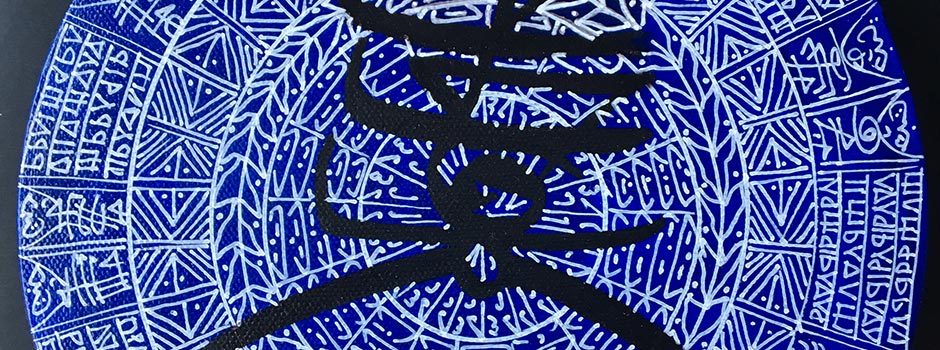
SOLO EXHIBITION AT OCTOBER GALLERY, LONDON (21 JUNE – 28 JULY 2018) Rachid Koraïchi’s New Works
May 10, 2018 Exhibition

 Rachid Koraïchi at work / Courtesy October Gallery and the artist
Rachid Koraïchi at work / Courtesy October Gallery and the artist
Born in Ain Beida, Algeria, in 1947, Rachid now lives and works in Tunisia and France. He studied at the Institute of Fine Arts and École supérieure des beaux-arts in Algiers, before continuing his studies in Paris at the École nationale supérieure des arts décoratifs, the Institut d’urbanisme and L'École supérieure des beaux-arts in Paris.
 Work from Les osties bleues series, 2018, by Rachid Koraïchi / Courtesy October Gallery and the artist
Work from Les osties bleues series, 2018, by Rachid Koraïchi / Courtesy October Gallery and the artist
Koraïchi’s impressive oeuvre includes silk hangings, ceramics, sculptures, as well as works on canvas and paper. For Rachid Koraïchi, art is an ancient path into the unknown. Signs and symbols from civilisation’s oldest languages are abstracted and deconstructed in Koraïchi’s work to create a new visual vocabulary.
In his new series of work the artist explores our connections to the earth as a source of life. The works are blue and white canvases (titled ‘Les osties bleues’ — a reference to Sacramental bread) and wall mounted square ceramics (created by Rachid with a specialized atelier in Barcelona). Koraïchi continues to use a limited palette emphasizing the graphics power of his inscriptions.
 Work from Les osties bleues series, 2018, by Rachid Koraïchi / Courtesy October Gallery and the artist
Work from Les osties bleues series, 2018, by Rachid Koraïchi / Courtesy October Gallery and the artist
These new pieces by Koraïchi further explore the ethereal qualities of blue. The colour is "always connected with the heavens and is also the colour of invisibility," Koraïchi stated in an interview Rachid Koraïchi: Eternity is the Absence of Time. "A strange notion – perhaps – but if you look at the sea – it’s blue! But, cup a handful of sea-water in your hand and the blue is gone!"
At the core of these works is the earth: the terracotta for the ceramics and the cotton for the canvas. Rachid Koraïchi continuously works with natural materials, another example of this was time spent with potters in Djerba, Tunisia, for his 1995 piece Lettres d’Argile in which he worked with non-toxic materials to reinvigorate a near-lost pottery tradition.
 Work from Les osties bleues series, 2018, by Rachid Koraïchi / Courtesy October Gallery and the artist
Work from Les osties bleues series, 2018, by Rachid Koraïchi / Courtesy October Gallery and the artist
Rachid Koraïchi’s work is represented in major public collections, including the British Museum, London, UK; the Herbert F. Johnson Museum of Art, New York, USA; the Newark Museum, Newark, USA; Musée d'Art Moderne de la Ville de Paris, Paris, France; Museum of Modern Art, Cairo, Egypt; the National Museum Gallery, Amman, Jordan; the Miami Art Museum, Miami, USA and the Smithsonian, National Museum of African Art, Washington D.C., USA.
In 2011, Rachid Koraïchi won the prestigious Jameel Prize at the Victoria and Albert Museum, London, exhibiting seven large-scale banners from The Invisible Masters series.
 Work from Les osties bleues series, 2018, by Rachid Koraïchi / Courtesy October Gallery and the artist
Work from Les osties bleues series, 2018, by Rachid Koraïchi / Courtesy October Gallery and the artist
The Guggenheim, Abu Dhabi acquired the installation of Rachid Koraïchi’s Path of Roses (1995-2005) a monumental celebration of Sufi mystic and poet JalÄ al-DÄ«n al- RÅ«mī’s physical and spiritual journey of enlightenment across Asia, Middle East and Arabia in the 13th century.
The exhibition will be open on June 21 and will run until July 28, 2018 at October Gallery, London.
Comments
Add a comment